Small Home Gazette, Spring 2020
The Velvet Touch: Van Briggle Pottery
by Donald-Brian Johnson
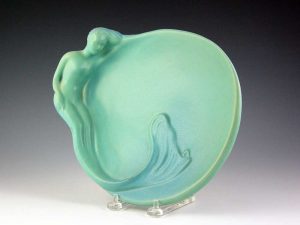
Mermaid tray, 7½ inches in diameter.*
A palette of vibrant color. Nature’s essence, captured in clay. These are the magical elements behind the enduring appeal of Van Briggle pottery. Until its closing in 2012, the company was America’s oldest continuously operating art pottery. Nestled at the base of Pikes Peak in Colorado Springs, Van Briggle Pottery turned out its first artware in 1899. Soon, collectors were clamoring for the pieces created by Artus and Anne Van Briggle and their successors. The lines are simple, yet evocative; the glazes deep and velvety; the finished product hypnotically alluring.
The Early Years
 Born in Felicity, Ohio, in 1869, Artus Van Briggle moved to Cincinnati while still in his teens, finding employment at the famed Rookwood Pottery. His skill as a decorator brought him to the attention of Maria Storer, Rookwood’s founder. In 1893, Storer sponsored Artus’ further studies in Paris.
Born in Felicity, Ohio, in 1869, Artus Van Briggle moved to Cincinnati while still in his teens, finding employment at the famed Rookwood Pottery. His skill as a decorator brought him to the attention of Maria Storer, Rookwood’s founder. In 1893, Storer sponsored Artus’ further studies in Paris.
There, he became fascinated by pottery produced during the Chinese Ming dynasty, particularly by its soft matte glazes. The technique used to produce these true-to-nature’s-colors glazes had been lost in time; resurrecting it became his obsession. (He also met fellow art student Anne Lawrence Gregory who, in 1902, became his wife.)
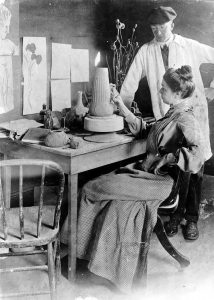
Artus and Anne Van Briggle.
In 1896, Van Briggle returned to the U.S., and the couple moved to Colorado in 1899. Artus, suffering from the onset of tuberculosis, hoped that the higher, drier climate might benefit his health.
Settling in Colorado Springs, he continued his glaze experimentation, utilizing native clays from the vicinity of the Garden of the Gods.** In 1900, Van Briggle finally achieved his goal: the marble-like soft glaze of the Ming period was successfully married to the sturdy clays of Colorado. In December 1901, Van Briggle offered pottery to the public. All 300 pieces in the initial run were immediately snapped up, and a pottery legend was born.
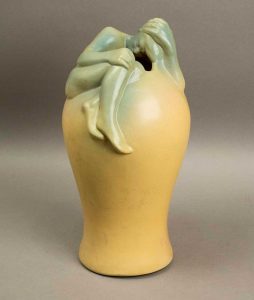
Despondency vase.
In 1902, the Paris Salon recognized his innovative glaze and design work with varied awards. In 1903, “Despondency,” a vase with the figure of a sorrowful woman coiled around the mouth, was a Salon first-place winner. But in July 1904, at the age of 35, Artus died. The company was now in the hands of Anne.
Anne built on the creative foundations the pair had established, expanding the company’s output and workforce. She continued to produce his designs and added some of her own. More importantly, she also spearheaded the 1907-08 construction of the famed Van Briggle Memorial Pottery complex.
 From the moment it opened, the Pottery was a must-see tourist destination. Designed by Dutch architect Nicolass van den Arend, the Pottery had a folksy Flemish manor-house design. Anne designed more than 5,000 tile and terra cotta pieces for the exterior of the building which served as the company’s salesroom, pottery plant and headquarters. Tourists visited to see the architecture; get a free tour; and buy tiles, terra cotta, or pottery. At the time, the company was one of only a few art pottery plants in the country open to the public.
From the moment it opened, the Pottery was a must-see tourist destination. Designed by Dutch architect Nicolass van den Arend, the Pottery had a folksy Flemish manor-house design. Anne designed more than 5,000 tile and terra cotta pieces for the exterior of the building which served as the company’s salesroom, pottery plant and headquarters. Tourists visited to see the architecture; get a free tour; and buy tiles, terra cotta, or pottery. At the time, the company was one of only a few art pottery plants in the country open to the public.
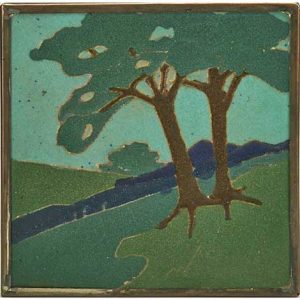
Van Briggle landscape tile, 1907.
While most associate the Van Briggle name with decorative artware, this was an all-purpose pottery. Among the numerous products produced were tile, both plain and decorative; enameled brick; architectural embellishments; mantle inserts (as well as complete mantles); garden furniture; lamps and electrical fixtures; wall fountains; and even advertising novelties!
Van Briggle Artware
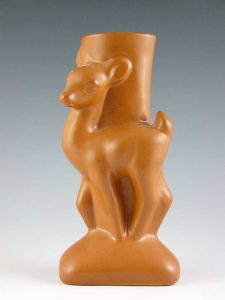
Deer vase, 9 inches high.*
Of course, the major drawing card for Van Briggle has always been its line of artware, first premiered by Artus. Some pieces are utilitarian (vases, bowls, planters, candleholders); some, such as figurines and wall plaques, are purely decorative. Although nominally Art Nouveau in its use of velvety-rich muted color, swirling lines, and soft-edged shapes, Van Briggle is really at home in any era.
As with any collectible on the market for over 100 years, the older pieces are the priciest. Early Van Briggle pottery fetches thousands; more recent items, some of which replicate earlier styles in new glaze colors, are available in the low hundreds or less.

Examples of “double A” mark; all authentic.
A wide variety of valid, incised Van Briggle markings exists, and entire reference books are devoted to their delineation. One of the most common marks is the “double A,” enclosed in a square. According to the Pottery, it was devised by Anne “to symbolize the unity of mind and spirit that defined their life together.”
The Final Years
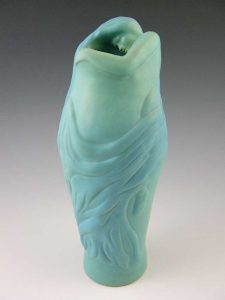
Lorelei vase re-issue from original mold, 11 inches high.*
In 1912, Anne left the company to pursue her passion for painting. The company went through several owners, bankruptcy, a war-imposed closure, and other problems over the next several decades, before re-emerging as a prosperous force in the 1950s. While new products were introduced, successive owners retained the styling and technique Van Briggle clients had come to appreciate.
In the 1990s, an assortment of unauthorized Van Briggle look-alikes entered the market. Buyers with limited exposure to “the real thing” were caught with their hopes up and their wallets open. Fortunately, the flow of fakes eventually slowed to a trickle, particularly following the company’s 2012 closing. Buyers should, however, still be cautious. Check for referenced markings; smooth surface texture; and full-dimensional, rather than faded, uneven, colors. If the price “seems too good to be true,” it is.
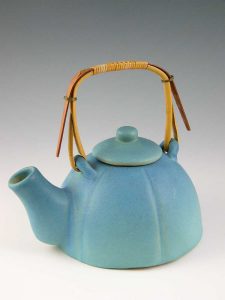
Teapot, 7 inches high.*
As at the beginning, today’s Van Briggle collectors remain entranced by its stylistic timelessness. The richly muted colors, swirling lines, and soft-edged shapes blend well with any décor. A Van Briggle piece “fits” because it does not compete. Instead, Van Briggle complements.
*Van Briggle artware courtesy of Hank Kuhlmann.
** The Garden of the Gods Park is a registered National Natural Landmark in Colorado Springs. The park’s famous red rocks formed millions of years ago due to upheavals in the earth’s surface and erosion. The rocks are conglomerates of red, pink, and white sandstones and limestone.
Donald-Brian Johnson is the author of numerous Schiffer books on design and collectibles, including Postwar Pop, a collection of his columns. Please address inquiries to: donaldbrian@msn.com.
Editor’s Note

Dating Van Briggle pottery is a challenge. The pottery had been in production for over 100 years, and many of the shapes and glazes were used repeatedly or slightly modified.
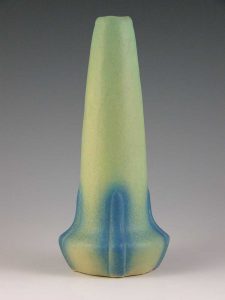
Tubular vase with dark blue base highlights, 8¼ inches high.*
The mark on the bottom of an early piece of Van Briggle pottery consists of the “double A” mark, the Van Briggle name, year of production in Roman numerals, and often a design or glaze number. The Roman numerals disappeared about the time “Colorado Springs” or “Colo Spgs” was added. The marks will vary in appearance as they were incised, or scratched in, by hand.
Differences in script, clay color, bottom residue, and artist initials can also help to date a piece of pottery. Pieces made prior to 1920 have more interesting glazes (sometimes multiple glazes applied to one piece) and more detail in the mold, adding to their value.
Below are some resources to help you identify and collect Van Briggle pottery.
Resources
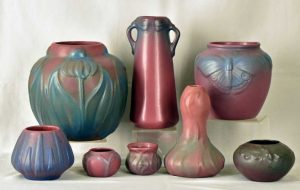
Collection of unusual Van Briggle pottery.
Books:
- The Collector’s Encyclopedia of Van Briggle Art Pottery: An Identification & Value Guide by Richard Sasicki and Josie Fania. November, 1993; updated January 1, 1995.
- Collector’s Guide to Van Briggle Pottery by Scott H. Nelson, Lois K. Crouch, et al. June 1, 1986.
- The Story Behind the Clay: A Comprehensive Guide to Commissioned Van Briggle Specialty Pieces by David O. Swint and Sharon K. Swint. May 1, 2005.
Websites:











